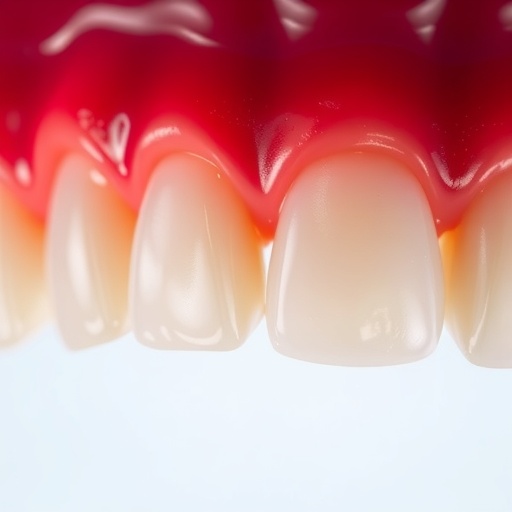In a groundbreaking study led by a team of researchers including Chen, J., Xiong, Y., and Liu, B., a pivotal connection between interleukin-6 (IL-6) positive fibroblasts and the pathology of severe periodontitis has been elucidated. The findings, published in the Journal of Translational Medicine, unveil the substantial role that IL-6+ fibroblasts play in orchestrating a pro-inflammatory milieu in patients suffering from severe forms of periodontitis. This research not only emphasizes the cellular dynamics at play in periodontal tissue but also sheds light on potential therapeutic pathways to ameliorate periodontal disease outcomes.
Periodontitis, an inflammatory disease that affects the supporting structures of the teeth, is marked by significant tissue loss and is associated with various systemic conditions. The chronic inflammation characterizing periodontitis is fueled by a cascade of immune responses that, in turn, are moderated by numerous cytokines and molecular players. Among these, IL-6, a multifunctional cytokine, has emerged as a key participant in the pathophysiology of inflammation, especially in oral tissues. The study notably implicates IL-6+ fibroblasts as critical agents of this inflammatory response, particularly in the aftermath of non-surgical periodontal therapy.
Fibroblasts, ubiquitous cells that provide structural support to tissues, can acquire diverse functional phenotypes in response to their microenvironment. When stimulated by pro-inflammatory signals, such as those prevalent in periodontitis, fibroblasts can adopt an inflammatory phenotype characterized by the production of cytokines including IL-6. This phenomenon is of particular interest, as the presence of IL-6+ fibroblasts has now been linked with sustaining inflammation even after therapeutic intervention, complicating the typical treatment approach.
The investigation involved the examination of gingival tissue samples from patients diagnosed with severe periodontitis. These samples revealed a notable increase in IL-6+ fibroblast populations, suggesting that, despite undergoing non-surgical periodontal therapy, the inflammatory state persists due to these activated fibroblasts. Such observations point to the idea that traditional therapeutic measures may not adequately address the underlying cellular behaviors that perpetuate this condition.
Non-surgical periodontal therapy is typically the first-line treatment for periodontitis, focusing on the removal of plaque and calculus to reduce inflammation. However, the findings from this study warrant a reconsideration of treatment paradigms. The potential for IL-6+ fibroblasts to maintain a state of inflammation raises questions about the efficacy of current therapeutic approaches, particularly for patients with severe disease manifestations who may display resilient inflammatory responses.
To further dissect the functional implications of IL-6+ fibroblasts, the researchers conducted in vitro experiments, demonstrating that these cells significantly enhanced inflammatory cytokine production in co-culture settings. When stimulated by other inflammatory mediators, IL-6+ fibroblasts perpetuated a cycle of inflammation, suggesting a self-sustaining loop that could contribute to tissue destruction in periodontitis. This vicious cycle showcases the importance of targeting these fibroblasts in developing more effective treatments.
Furthermore, the study highlights the potential for therapeutic interventions aimed at modulating the activity of IL-6+ fibroblasts. By employing strategies to downregulate the inflammatory actions of these cells, it may be possible to not only reduce the inflammatory component of periodontitis but also foster a healthier tissue recovery post-therapy. Forward-thinking approaches could involve the use of IL-6 inhibitors or agents that reprogram fibroblasts to a more quiescent, reparative state.
The implications of this research extend beyond the realm of periodontitis. The presence of inflammatory fibroblasts is not exclusive to oral diseases but is a common feature in many chronic inflammatory conditions. As such, understanding the mechanisms that govern their behavior in periodontitis may provide insights applicable to other fields, including rheumatology, dermatology, and chronic inflammatory diseases at large.
In the context of personalized medicine, profiling IL-6+ fibroblast populations could lead to the identification of patients at higher risk for persistent periodontitis. This stratification could involve developing tailored therapeutic regimes that address the unique inflammatory signatures present in individual patients, improving overall treatment outcomes.
While the study presents compelling evidence regarding the role of IL-6+ fibroblasts in periodontal disease, future research is paramount in validating these findings across larger, more diverse cohorts. It will be essential to explore the full mechanistic pathways underlying the function of these fibroblasts and their interactions with other immune cell populations in periodontal tissues.
Moreover, as periodontal disease is intimately linked with systemic health issues—such as cardiovascular disease and diabetes—it is crucial to understand how modulating IL-6+ fibroblast activity could intersect with broader health outcomes. By targeting these inflammatory cells, not only might periodontal health be improved, but potential systemic benefits may also arise, emphasizing the interconnectedness of oral health and overall well-being.
In summary, the study by Chen et al. provides a pivotal insight into the role of IL-6+ fibroblasts in severe periodontitis, establishing a foundation for further research into innovative therapeutic strategies. As the field of periodontal therapy continues to evolve, understanding and targeting the cellular underpinnings of inflammation will be key to revolutionizing our approach toward managing and treating this widespread disease.
The findings not only deepen our understanding of periodontal disease ecology but also herald a new dawn in periodontal therapy, where the focus shifts toward effectively controlling the persistent inflammatory states that complicate recovery. Moving forward, the spotlight will invariably be on IL-6+ fibroblasts as potential targets in the quest for more effective, patient-centered treatments that translate into improved patient outcomes in the management of periodontitis and beyond.
Subject of Research: The role of IL-6+ fibroblasts in severe periodontitis and their impact on the pro-inflammatory microenvironment following non-surgical periodontal therapy.
Article Title: IL-6+ fibroblasts contribute to shaping the pro-inflammatory microenvironment in severe periodontitis after non-surgical periodontal therapy.
Article References:
Chen, J., Xiong, Y., Liu, B. et al. IL-6+ fibroblasts contribute to shaping the pro-inflammatory microenvironment in severe periodontitis after non-surgical periodontal therapy.
J Transl Med 23, 1109 (2025). https://doi.org/10.1186/s12967-025-07132-8
Image Credits: AI Generated
DOI: 10.1186/s12967-025-07132-8
Keywords: IL-6, fibroblasts, periodontitis, inflammation, periodontal therapy.




